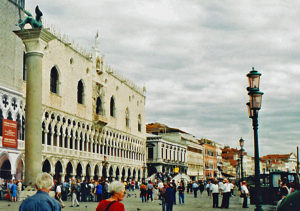
Southern Façade of Doge’s Palace in Venice (Photo by Don Knebel)
The Republic of Venice, which arose in the seventh century, was led by a doge, elected for life by a council of leading Venetians. The extant Doge’s Palace, completed in the fifteenth century, occupies the site of earlier palaces destroyed by fires. The site lies just south of St. Mark’s Basilica, which the doges used as their chapel. The palace includes apartments for the doge and his family, administrative and judicial offices, and areas where the doge received visitors. Walls and ceilings of the palace are decorated with outstanding works of Italian art, much of it Christian.
The Great Council was a law-making body comprising adult males of important Venetian families. The chamber housing the Great Council was one of the largest rooms in Europe, measuring 175 feet by 82 feet. A painting by Tintoretto showing scenes from the Final Judgment covers one entire wall, making it what is said to be the largest canvas painting in the world. Just below the elaborate gilded and painted ceiling of the Chamber are portraits of 75 of the first 76 doges, each identifying his greatest achievement. The space for the portrait of Marino Faliero, the 55th doge, contains only a painted black shroud. In 1355, Faliero was beheaded inside his palace and his body mutilated for attempting a coup against the Venetian aristocrats, allegedly to defend the honor of his crudely slandered wife.
The story of the portrait missing from the Doge’s Palace inspired Lord Byron to write a five-act tragedy chronicling Faliero’s demise. The poem inspired a famous Delacroix painting and a Donizetti opera.
Comments are closed.